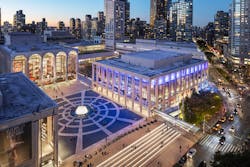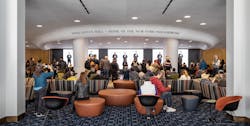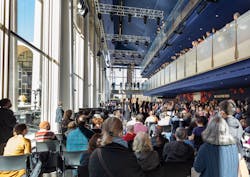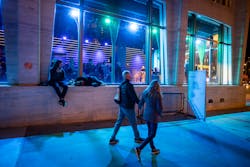PROJECT | Agile design - LEDs flex their versatility at David Geffen Hall
Walking up the steps to Lincoln Center’s Josie Robertson Plaza puts you at the center of three iconic New York cultural venues: the David H. Koch Theater to the south, the Metropolitan Opera House to the west, and the newly renovated David Geffen Hall, home of the New York Philharmonic, to the north. The trio’s soaring colonnades and ivory-colored travertine can straddle the line between majestic and imposing. But, at dusk, when Geffen Hall transitions into a lantern of color, the atmosphere becomes energized — delivering exactly what the venue’s $550 million renovation hoped to achieve: an increase in public engagement and interest.
“The use of color in this building is very powerful,” said Paul Marantz, founding principal of locally based Fisher Marantz Stone (FMS) and consulting lighting design principal for the Geffen Hall renovation. “It started out as a stolid, midcentury modern building [with] ambitions to be useful for things that are more colorful in their nature. The use of color differentiates the project from everything that came before.”
Transparency was another approach, where the renovation has revealed indoor activities through expansive glass curtain walls. The owners were “adamant about making sure that the hall reinvented itself and made itself more accessible to more people,” said FMS principal and studio director Paula Martinez-Nobles, the firm’s principal-in-charge of the renovation.
Geffen Hall also exhibits newfound flexibility in its architectural programming. “It’s capable of being of a motion picture theater, a live performance theater, a dance theater, or any number of things,” Marantz said.
That agility extends to the project’s lighting design, Martinez-Nobles said. Inside Geffen Hall, the public spaces, corridors, and corners designed by Tod Williams and Billie Tsien Architects (TWBTA) can flex into circulation, performance, and gathering spaces. The lighting is equally adaptable and uses entirely LED technologies, most of which are 0–10V dimmable and operate via Electronic Theatre Controls (ETC) solutions.
Though FMS briefly considered using conventional light sources, particularly in Geffen Hall’s concert hall, the Wu Tsai Theater, designed by Diamond Schmitt Architects and FMS affiliated company Fisher Dachs Associates (FDA), Marantz said the risk of technology obsolescence was the deal breaker. “I might find old light sources appealing in some way,” he said, “but it doesn’t matter because they are going to disappear from an availability standpoint.”
Into the theater
The glamour of Geffen Hall’s new public and circulation spaces is immediately apparent through the lighting fixtures, a mix of bespoke and commercial products. Striking full-height upright chandeliers, or torchieres, feature spirals of arrayed metal petals finished in a matte gold and uplit by LED point sources of an illuminated handrail oriented vertically. The sculptural fixtures combined the efforts of New York studio Chen Chen & Kai Williams, Brooklyn, N.Y.–based Aurora Lampworks, TWBTA, and FMS.
The ticket office, previously enclosed and tucked away from the public, has been folded into the welcome center and LeFrak Lobby, which are open to the public. Large, beveled Flos Kap 145 downlight modules with USO Kap Ø145 plates recessed in the plaster ceiling mimic the buzz and activity of showgoers and passersby stopping in for a respite or a performance on the lobby’s own stage or video wall. “The fixtures are a constellation of big sources … that echo the chaos and movement in the space,” Martinez-Nobles said. Though most lights operate on ETC controls, a row of fixtures near the stage is Bluetooth-enabled for easy control by facilities personnel.
At Geffen Hall’s prominent northeast corner, on 65th Street and Columbus Avenue, the Griffin Sidewalk Studio can reveal its live performances through its glass curtain walls, which are illuminated with 25 ETC ColorSource CYC wall washers, said Jeff McCrum, FDA associate and stage lighting and systems design lead. Another 50 stage lights, an equal mix of ETC ColorSource Spot Jr and ETC ColorSource PAR products in deep blue, facilitate different performance configurations. A dark slatted backwall is outfitted with a series of linear LEDs every 6 to 8 inches to form a low-resolution video screen for outside traffic.
On the plaza side of Geffen Hall, the Hess Grand Promenade offers another event and performance space. The triple-height ceiling hides supports for rigging stage lighting — High End Systems SolaFrame 1000 fixtures — as needed for events. Additionally, up to 30 ETC Source Four LED Series 3 fixtures can be mounted on metal pipes lining the balcony walkway.
A shimmering mosaic tile stair wall guiding ticketholders to the main auditorium is enhanced by dimmable 1/2-inch-diameter recessed CSL Whisper Lights. The upper levels also reveal another colorful and prominent motif of the Geffen Hall renovation: a navy, felt wall painted with falling, large-scale red petals. USAI Lighting 3-inch round wall washers spaced 3 feet on center uniformly illuminate the abstract mural, which wraps the walls of the centrally located Wu Tsai Theater, as desired by the client. “It is clearly the end of one room and the beginning of another,” Marantz said, referring to the wall’s separation of public spaces and the concert hall.
Showtime! Taking center stage
Once the show is ready to begin, ticketholders enter the approximately 2,200-seat Wu Tsai Theater, illuminated in considered, purposeful layers. Warm beech wood panels wrap walls and balconies from floor to ceiling; the striated panels are rippled and shaped for optimizing the auditorium’s acoustical performance, a primary driver for the renovation. To break up the monotony of the wood, the lighting designers sought to add visual interest. “We hoped to make it rich in every way we could, knowing that [the wood] is all of a uniform color,” Marantz said. FMS specified an oblique wall washer it customized with Radiant Architectural Lighting to cast 2700K light a couple degrees toward the stage, instead of perpendicular to the wall surface; the designers also varied their light intensity.
Working within the constraints of the acoustical requirements, the designers hid, recessed, or surface-mounted the wall washers where, for example, an architectural ceiling pocket exists for acoustical purposes — or ceases to exist due to the balcony layout. Additionally, Martinez-Nobles said, “the architect wanted to highlight the balcony fronts to make the grand room feel a bit more intimate” because the balconies are the “tightest and closest to you as an audience member.” The resulting dappled lighting softens and enriches the expanse of wood. The general house lights washing over a familiar red petal motif fabric covering audience seats is 3000K.
And of course, no performance venue is complete without its stage lighting, whose design was overseen by FDA’s McCrum. “We were responsible for specifying the lighting system that controls the lights on both sides of the proscenium,” he said. Illuminating performers, sets, and anything else that might appear on the reconfigurable stage was in FDA’s scope of work.
As many as 95 High End Systems SolaFrame Theatre moving light fixtures and 160 ETC Source Four LED Series 3 stage lights hover in the grid approximately 50 feet above the audience for production crews to use, customize, or move around. The latter fixtures have “eight chips, or colors, and we mix to white,” McCrum said. Previously, he said, stage lights with LED sources had difficulties rendering “Shakespearean colors” — red and warm browns — but ETC’s product, launched in March 2022, “feels like we’re there in terms of replicating halogen.”
The lower operating temperature of LEDs compared to traditional halogen sources was welcomed by the facility for reducing the cooling load of the mechanical system. “There’s a big difference between a fixture that’s 165W or 200W and one that is 750W or 1,000W,” McCrum said. Still, he recognized that some long-running, traveling shows or renters of the space might use a halogen setup, so he included through-power dimmer modules in the stage lighting control system that can switch to a relay as needed. The crews for these shows would “have to hang their own truss and bring in their own lights, but they can still plug into the existing circuits and use it as a halogen space,” he said.
Accompanying the lighting grid above the orchestra seating are a series of acoustic reflecting panels, which also provide housing for a set of luminaires that have become a theater signature: 47 custom firefly pendants, whose kinetic dance signals the start of a production. With an acrylic shade 3D printed by EVTSC, the 6-, 8-, and 12-inch-diameter polyhedrons twinkle, rise, and fall on independent motorized winches, following a preprogrammed scenario communicated via DMX. Inside each polyhedron is an ETC 4.4W ArcLamp with a candelabra base socket.
Designing and installing the fireflies required the collaboration of 20 people, Martinez-Nobles estimated, including team members from DSA, FMS, FDA, and Aurora Lampworks. Conducting mock-ups during the COVID pandemic was challenging, to say the least. Each firefly must snap securely into its own pocket within the acoustic panels, disappearing from view when a show begins and the stage lights take over. The orientation of the acoustic panels can also change, depending on the performance needs, to the point of being completely vertical; as a result, the fit must be perfect to prevent the fireflies from falling out.
Beyond the lighting grid, several of the ETC Source Four LED Series 3 stage lights hang on horizontal pipes under different balcony levels, some of which may seem to point in directions askance from center stage. McCrum explained this allows the direction of light to come from the front, side, or back of performers; for example, a conductor might be illuminated from 45° instead of backlit to allow musicians to make comfortable eye contact with them.
Other lighting design highlights include the installation of a suspended expanded bronze mesh toward the back of house that hides an existing patterned plaster ceiling, which performed fine acoustically and was left intact. The semi-glossy metal complements the warm interior finishes while capturing and dissipating some of the extraneous bounce light, Martinez-Nobles said.
Among the uppermost, third-tier seating, shielded, dimmable reading lights integrated into seatbacks allow audience members without the benefit of overhead lighting to read their programs. Marantz was inspired by memories of Radio City Music Hall in his youth, where holding down a push button would turn on a seatback light. “I thought that was a really nice idea,” he said.
All in controls
The Wu Tsai Theater’s stage and architectural LED lights are largely controlled either through an ETC EPS Apex 10 console or the Paradigm Architectural Control Processer, which oversees up to four DMX universes of architectural lighting. Lighting can also be controlled via touch screens positioned by the stage or via the console, which can be moved throughout the space. “If you can stand on stage and see a light fixture, [you can] control that light,” McCrum said. The fireflies are individually controlled via DMX through Mosaic software to handle the series of programmable queue stacks instructing the winches and fixtures.
Throughout the concert hall, Ethernet is distributed for data and then converted into a DMX signal via Ethernet gateways, McCrum said. In the Sidewalk Studio, lighting is controlled with an ETC Eos Ion Xe console, while the promenade lighting relies on the ETC Eos Gio @5 console, though McCrum added that any of the ETC consoles can be used in Geffen Hall’s spaces.
In October 2022, David Geffen Hall opened its doors to great fanfare, a remarkable feat given that the lighting designers only began working on the project in September 2019, shortly before the start of the COVID pandemic. Like many sectors, the project team had to contend with supply chain issues, long lead times, increased costs, delayed components, and quality control issues. “We were doing gymnastics with the sources and tools we had available and stretching their capabilities,” Martinez-Nobles said. Through ingenuity and a lot of collaboration across disciplines, the entire design and construction team figured out how to make the show go on — and two years ahead of the original phased project schedule for David Geffen Hall.
PROJECT CREDITS
Architect (public spaces): Tod Williams Billie Tsien Architects | Partners
Architect (concert hall): Diamond Schmitt Architects
Theater planner: Fisher Dachs Associates
Lighting designer (architectural lighting and public spaces): Fisher Marantz Stone
Lighting designer (performance and stage lighting): Fisher Dachs Associates
Construction management: Turner Construction Co.
Structural engineer: Thornton Tomasetti
Mechanical and electrical engineer: Kohler Ronan
Lighting manufacturers: Aurora Lampworks, CSL, ETC, Flos, GVA, Radiant Architectural Lighting, USAI Lighting
Lighting controls: ETC Paradigm
Firefly lights choreography and programming: Vortex Lighting, Inc.
WANDA LAU is editorial director of LEDs Magazine, Architectural SSL, and Smart Buildings Technology. She previously served as executive editor of Architect magazine and worked for a decade in the architecture, engineering, and construction industry.
*Project credits updated Feb. 21, 2023.
For up-to-the-minute LED and SSL updates, follow us on Twitter. You’ll find curated content and commentary, as well as information on industry events, webcasts, and surveys on our LinkedIn page and our Facebook page.

Wanda Lau | Editorial director, LEDs Magazine, Architectural SSL, and Smart Buildings Technology
Wanda Lau is an award-winning editor, writer, and podcaster whose work appears in several publications, including Architectural Lighting and Architect, where she was most recently the executive editor. In 2021, she was named one of Folio: and AdMonsters' Top Women in Media, in the DEI Champions category. Along with working a decade in the architecture, engineering, and construction industry, she holds a B.S. in civil engineering from Michigan State University, an S.M. in building technology from MIT, and an M.A. in journalism from Syracuse University.










